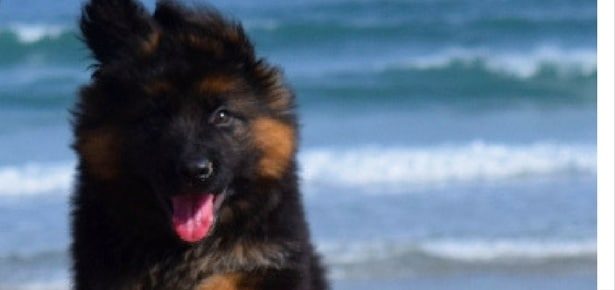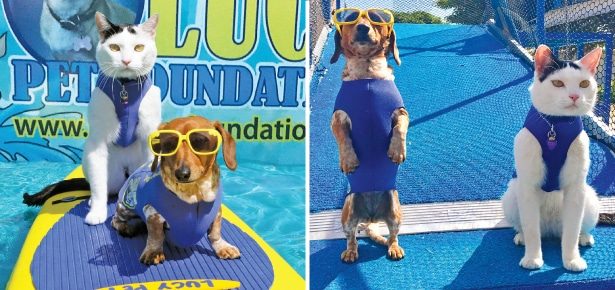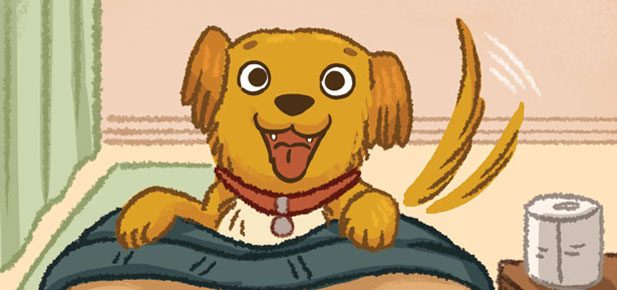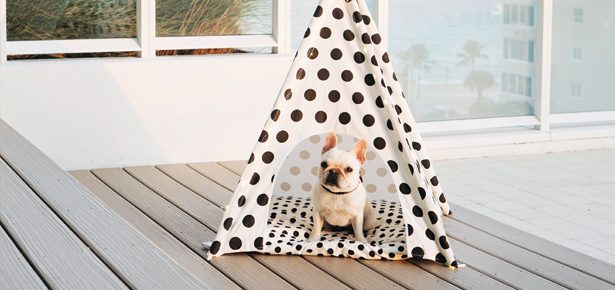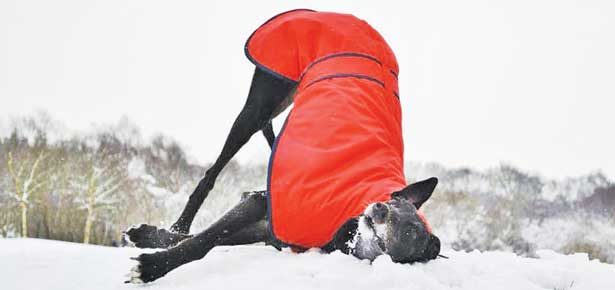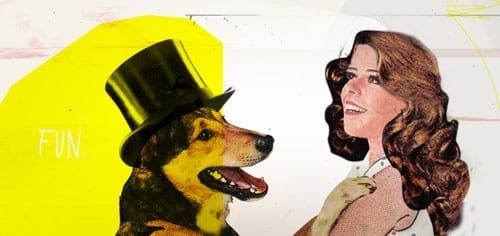
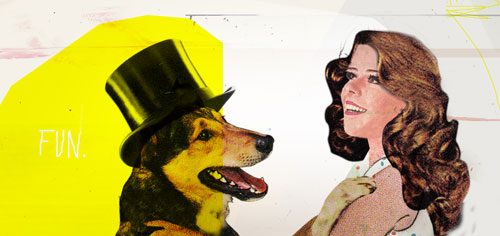
Freestylin’
A canine-freestyle newbie and her “exuberant” dog test their skill—and the instructor’s patience
The first image that materialized in my mind when I was asked to report on canine freestyle dancing was that of Bobby Hill, underachieving son on the King of the Hill TV series, waltzing with a cartoon Westie. For those of you familiar with the show and said character’s lack of grace, you’ll understand my apprehension at prancing about with my 105-pound Boxer/American Bulldog mix, Cash, as my dance partner.
Nonetheless, I was game, my love for everything dog-related forcing me to ignore the silliness I considered inherent to the sport. I wasn’t the only one with misgivings as to my participation, however. Once I agreed to be Modern Dog’s dancing Diane Sawyer, our editor made it abundantly clear that my purpose in undertaking this task was not mockery but unbiased reporting. What can I say? She knows me well. It was with this admonition that Cash and I signed up for our first canine freestyle dance lesson.
Just as most of my family and friends did, you may be asking yourselves, “what is freestyle dog dance?” According to the World Canine Freestyle Organization, musical freestyle is “a choreographed musical program performed by handlers and their dogs.” These carefully composed routines demonstrate obedience, skill, creativity, athleticism, and, most importantly, a deep connection between handler and dog. (Outlandish fashion sense is also frequently on display).
Widely—though contentiously—thought to have originated in British Columbia in the late 80s, canine freestyle dancing started off as just that—dancing with your dog to music. Once the movement began to gain steam, other forms of dog dance started to develop, such as dressage, the form of freestyle Cash and I are trying. Also known as heelwork-to-music, dressage is a technical version of the sport that was originally designed to create more structure in the training and to prevent people from advancing to more difficult steps too early. Basic dressage requires that the dog can heel, whereas more advanced levels call for much more complex moves, such as one requiring the dog to balance on its hind legs and take four steps forward, then four steps back, followed by four steps to the right and then four steps to the left, essentially making the sign of a cross, all in time to the music. Master-level competitors are instructors who themselves compete in the ring.
As we made preparations for our first day of class, visions of top hats, sequins, and intricately choreographed routines set to 90s hip-hop danced about in my head. Cash and I didn’t want to show up overdressed and make a bad impression, though, so we erred on the side of caution and left our bejewelled vests and sparkling fedoras at home, instead opting for casual athletic attire. And thank goodness. As we entered the gymnasium filled with dancing dog talent, I was suddenly overcome by a wave of ineptitude. These dogs were incredible. All of my assumptions and preconceptions were catapulted out the window as I took in the scene before me: handlers and performers in perfect sync, moving together rhythmically to classical music. Cash peered up at me with the same look of trepidation that was doubtless written on my face. What had we gotten ourselves into?
Before I was able to fully grasp our predicament or properly introduce ourselves to our instructor and classmates, Cash completely unravelled. Erupting into a torrent of violent barks and whines, he pulled maniacally on his leash, trying to break free of his shackles. It appeared that being surrounded by so many unfamiliar dogs was too much for him to handle. The other participants, both human and canine, kindly ignored his loud outbursts and continued on with their routines.
The instructor approached us and asked how much training Cash had; I stammered embarrassedly that he had none—obedience isn’t his bag. I suddenly found myself imagining the both of us seated in separate corners of the classroom sporting dunce caps. Once it became clear his tantrum was distracting the others, we decided he would take a quick stroll around the block with my co-handler while I stayed behind to observe.
This brief reprieve from mayhem offered me the chance to get to know the other handlers and their dogs. One by one, they each politely noted that Cash was a pretty pup, and were shocked to learn that his exuberant energy was contained within the body of a seven-year-old. Though perhaps their surprise at his age ought not to have been complimentary, driving as it was at his unhinged-ness, I couldn’t help but burst with pride at his handsome exterior and his ability to hide his age well (my dog, the George Clooney of canines!).
All of the handlers were happy to discuss their dogs’ history and experience with the sport. For the most part, the dogs in this particular class had been competing in freestyle since puppyhood, and, with the average dog’s age hovering around seven, they certainly weren’t beginners. I felt reassured that Cash was not a hopeless case; just a late starter. Plus, most of the canine performers were herding breeds: Border Collies, a Belgian Malinois, and an Australian Kelpie. The only non-herding breed, other than my miscreant, was a tiny Yorkie named Corabelle who seemed to have no trouble keeping up with her larger counterparts. While most of the dogs “bowed” after a performance, Corabelle “curtsied.” Enchanting, I promise you.
One couple in particular that caught my attention: Ali, the Kelpie, and her handler, Lydia. Working with Ali wasn’t Lydia’s first foray into the freestyle world; originally she began her dog dancing career with two Doberman Pinschers. Eventually it became clear that the dogs’ size wasn’t suited to her small frame, so in 2005, Lydia’s family welcomed Ali to their home and the twosome have been dancing together ever since.
When asked what attracted her to freestyle, Lydia admitted that the anonymity of performing in costume helped liberate her of her inhibitions.
“Having a dog as a dance partner and putting on a wig and costume frees me to do things I wouldn’t normally do as myself,” Lydia shared. One of her favourite aspects of freestyle is performing at care homes, noting “the residents love the dogs and light up when they see the dogs moving to music.” I could certainly relate; Ali’s perfectly timed two-step had me wondering whether she was meant to be bipedal rather than on all fours.
It became very clear these dogs were advanced, not only in their freestyle moves but in general obedience—not my pack’s regular crowd. I was amazed at their knack for concentration and astonished by the restrained praise bestowed upon them when a new step or move was executed correctly. These dancing dogs were obviously key players in a competitive and fast growing sport.
After his brief time-out, we brought Cash back in for one last attempt at a graceful debut. Despite our initial setbacks, we decided to throw caution to the wind and try our hand at the most basic move, a crawl. I managed to get Cash’s attention long enough for him to sit and then lie down, the position required for a crawl. I found myself down on my hands and knees, begging for compliance to save both our egos. I slowly crawled backwards, goading him to follow along with excited encouragement. Eureka! He followed me without the promise of delectable treats or food, correctly performing his first freestyle dance move. I couldn’t resist—we fell victim to our excitement, rolling carelessly in unrestrained delight, celebrating his colossal accomplishment.
Beaming with pride, we moved to the back room of the gym to rejoice privately, completely satisfied with our slow-moving progress. As we approached the back door, we were confronted by a perfectly coifed Poodle who ensnared Cash with her prim stance. I explained to the proud owner through a tight, nervous smile that he was friendly, hoping against hope he wouldn’t get too friendly. I breathed a sigh of relief as he jubilantly galloped back towards the other dogs, thankful that he was finally showing some restraint. But alas, the Poodle’s attraction proved to be too much, and, to my horror, my “world’s handsomest dog” lifted his leg and marked the wall in the senior’s center. We came so close to leaving with a semblance of pride. I can only surmise that it wasn’t meant to be.
Don’t take our initial failure as giving up; we’re going to give freestyle dressage another try, but this time at home. There are a variety of options available to pairs like us, too distracted by the opportunity for play to concentrate on the task at hand. You’ll find resources both online and through the multitude of freestyle organizations across North America that will provide instruction and tips to get you and your four-legged dancer off to a great start. For our initial at-home sessions, we’re going to try OnlineDogCoach.com; it’s free, easy, and will spare us both the humiliation and disappointment of having to compare ourselves to more talented dogs (and handlers!). Then again, we will have to endure the humiliating snickers from the unwilling spectators, both human and canine, who will be forced to watch our paltry performances from the living room sofa.
We may never be Baryshnikov and Pavlova performing at the Bolshoi, but by Dog, we’re trying.
Join the newsletter and never miss out on dog content again!
"*" indicates required fields
By clicking the arrow, you agree to our web Terms of Use and Privacy & Cookie Policy. Easy unsubscribe links are provided in every email.
